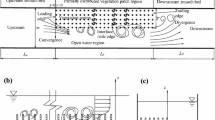Abstract
In this study, turbulent flows and morphological changes in an open-channel that has alternate vegetated zones are numerically simulated by using a three-dimensional model. The Reynolds-averaged Navier-Stokes Equations are solved with the k-ɛ model. The simulated flow structures compared well with the measured data in the literature. Through numerical experiments, the evolution of the mean flow and turbulence structures for different vegetation densities is presented. The vegetation was found to curve the flow, and the meandering flow pattern becomes more definite with increasing vegetation density. When the channel morphological changes are simulated with a series of floods, the initial rectangular channel becomes a compound channel and the flow pattern changes from a straight stream to a meandering stream. The evolution of vegetation zones after the floods indicates that vegetation zones are expanded in the leeward of the initial vegetation zones, and that the size of the vegetation zone is increased about 2.5 times.
Similar content being viewed by others
References
Ackerman, J. D. and Okubo, A. (1993). “Reduced mixing in a marine macrophyte canopy.” Functional Ecology, Vol. 7, No. 3, pp. 305–309.
Bennett, S. J., Prim, T., and Barkdoll, B. D. (2002). “Using simulated emergent vegetation to alter stream flow direction within a straight experimental channel.” Geomorphology, Vol. 44,Issues 1–2, pp. 115–126.
Choi, S.-U. and Kang, H. (2006). “Numerical investigations of mean flow and turbulence structures of partly vegetated open channel flows using the Reynolds stress model.” Journal of Hydraulic Research, IAHR, Vol. 44, No. 2, pp. 203–217.
Dunn, C. J. (1996). Experimental determination of drag coefficients in open channel with simulated vegetation, MSc Thesis, University of Illinois at Urbana-Champaign, Urbana, IL.
Finnigan, J. (2000). “Turbulence in plant canopies.” Annual Review of Fluid Mechanics, Vol. 32, pp. 519–571.
Fischer-Antze, T., Stoesser, T., Bates, P., and Olsen, N. R. B. (2000). “3D numerical modeling of open channel flow with submerged vegetation.” Journal of Hydraulic Research, IAHR, Vol. 39, No. 3, pp. 303–310.
Ghisalberti, M. and Nepf, H. M. (2002). “Mixing layers and coherent structures in vegetated aquatic flows.” Journal of Geophysical Research, AGU, Vol. 107, No. C2, pp. 3-1–3-11.
Ghisalberti, M. and Nepf, H. M. (2005). “Mass transport in vegetated shear flows.” Environmental Fluid Mechanics, Vol. 5, Issue 6, pp. 527–551.
Helmio, T. (2002). “Unsteady 1D flow model of compound channel with vegetated floodplains.” Journal of Hydrology, Vol. 269,Issues 1–2, pp. 89–99.
Ikeda, S. and Kanazawa, M. (1996). “Three dimensional organized vortices above flexible water plants.” Journal of Hydraulic Engineering, ASCE, Vol. 122, No. 11, pp. 634–640.
Lopez, F. and Garcia, M. (2001). “Mean flow and turbulence structure of open-channel flow through non-emergent vegetation.” Journal of Hydraulic Engineering, ASCE, Vol. 127, No. 5, pp. 392–402.
Neary, V. S. (2003). “Numerical solution of fully developed flow with vegetative resistance.” Journal of Engineering Mechanics, ASCE, Vol. 129, No. 5, pp. 558–563.
Nezu, I. and Onitsuka, K. (2001). “Turbulent structures in partly vegetated open-channel flows with LDA and PIV measurements.” Journal of Hydraulic Research, IAHR, Vol. 39, No. 6, pp. 629–642.
Olsen, N. R. B. (2004). A three-dimensional numerical model for simulation of sediment movements in water intakes with multiblock option, User’s Manual, Department of Hydraulic and Environmental Engineering, The Norweigian University of Science and Technology, Norway.
Patankar, S. V. (1980). Numerical heat transfer and fluid flow, Taylor and Francis Publishers.
Raupach, M. R., Finnigan, J. J., and Brunet, Y. (1996). “Coherent eddies and turbulence in vegetation canopies: The mixing layer analogy.” Boundary Layer Meteorology, Vol. 78,Issues 3–4, pp. 351–382.
Rodi, W. (1984). Turbulence models and their application in hydraulics, A State-of-the-art Review, Monograph Series, 2, IAHR Book Publication, Delft.
Schmid, B. H., Stephan, U., and Hengl, M. A. (2005). “Sediment deposition in constructed wetland ponds with emergent vegetation: Laboratory study and mathematical model.” Water Science and Technology, IWA, Vol. 51, No. 9, pp. 307–314.
Sharpe, R. G. and James, C. S. (2006). “Deposition of sediment from suspension in emergent vegetation.” Water SA, Vol. 32, No. 2, pp. 211–218.
Shimizu, Y. and Tsujimoto, T. (1994). “Numerical analysis of turbulent open-channel flow over a vegetation layer using a k-ɛ turbulence model.” Journal of Hydroscience and Hydraulic Engineering, JSCE, Vol. 11, No. 2, pp. 57–67.
Tsujimoto, T. (1999). “Fluvial processes in streams with vegetation.” Journal of Hydraulic Research, IAHR, Vol. 37, No. 6, pp. 789–803.
Tsujimoto, T. and Kitamura, T. (1996). “Deposition of suspended sediment near vegetated area during flood and growth of vegetated area in dry season.” Proceedings of International Conference on New Emerging Concepts for Rivers, Rivertech 96, Chicago, Illinois, USA.
Van Rijn, L. C. (1984). “Sediment transport part II: Suspended load transport.” Journal of Hydraulic Engineering, ASCE, Vol. 110, No. 11, pp. 1613–1641.
Van Rijn, L. C. (1987). Mathematical modeling of morphological processes in the case of suspended sediment transport, PhD Thesis, Delft University of Technology.
Wu, W., Shields Jr, F. D. Bennett, S. J., and Wang, S. Y. (2005). A depthaveraged two-dimensional model for flow, sediment transport, and bed topography in curves channels with riparian vegetation, Water Resources Research, AGU, 41, W03015.
Xiaohui, S. and Li, C. W. (2002). “Large eddy simulation of free surface turbulent flow in partly vegetated open-channels.” International Journal for Numerical Methods in Fluids, Vol. 39, Issue 10, pp. 919–937.
Zinke, P. and Olsen, N. R. B. (2007). “Modeling of sediment deposition in a partly vegetated open channel.” Proceedings of 32nd IAHR Congress, Venice, Italy.
Author information
Authors and Affiliations
Corresponding author
Rights and permissions
About this article
Cite this article
Kang, H. Flow characteristics and morphological changes in open-channel flows with alternate vegetation zones. KSCE J Civ Eng 17, 1157–1165 (2013). https://doi.org/10.1007/s12205-013-0346-5
Received:
Accepted:
Published:
Issue Date:
DOI: https://doi.org/10.1007/s12205-013-0346-5




